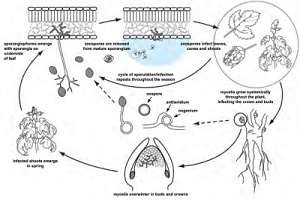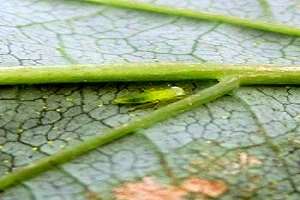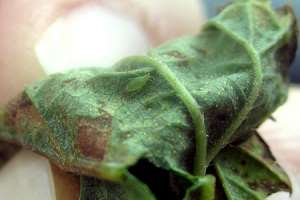By Erin Lizotte
Controlling downy mildew

While downy mildew pressure wasn’t as severe as 2015, some growers struggled to control downy mildew in 2016. As harvest wraps up, Michigan State University Extension has received inquiries around the availability and efficacy of post-harvest methods to combat this damaging disease. To properly answer this question, we need to fully understand the disease cycle of Pseudoperonospora humuli, the causal agent of downy mildew of hops (Figure 1) ) and how growing conditions in Michigan can affect the efficacy of late-season treatments.
Mycelium, the vegetative part of the downy mildew pathogen, overwinters in buds and crowns or plant debris (infected leaves, stems) left on the field. As shoots emerge in the spring, they may already be infected with this overwintering mycelium. As the hop bine begins to grow, the mycelium produces microscopic spore-bearing structures on the underside of leaves, giving the underside a gray, fuzzy appearance. These structures give rise to an asexual type of spore called zoospores. Zoospores move via wind and rain and act as the major cause of disease spread during the season, infecting new leaves, shoots and eventually even cones. The reproductive cycle that produces zoospores may repeat multiple times over the season, depending on temperature and moisture availability. Alternately, mycelium may also yield a resting spore through sexual recombination. It is unclear at this time if Michigan’s climate provides environmental conditions conducive to resting spore production.
When considering a post-harvest treatment, it is important to remember that the downy mildew fungus overwinters in the plant itself and is protected by the plant epidermis. While there are no data to suggest that post-harvest treatments are beneficial in terms of a reduction in disease next season, there is a general correlation between disease presence and severity from season to season that warrants further research.
Systemic fungicides are typically described as locally systemic, acropetal systemic (moving upward), or basipetal systemic (moving downward). Locally systemic materials are not useful for the treatment of downy mildew at this time because they do not move far from the site of application and don’t reach the sites where the pathogen overwinters. Truly systemic fungicides are taken up by the xylem or phloem tissue of the plant and moved to new tissues. Many of the systemic materials today are only translocated outward via the xylem or water-conducting tissues. Distribution of a systemic fungicide in the phloem or carbohydrate-conducting tissue tissues (basipetal translocation or downward movement) would include translocation into the crown and roots where downy mildew overwinters.
Fungicides labeled for hops that move systemically downward include Aliette and phosphite fungicides. Given the overwintering location of the fungus, a systemic fungicide with downward movement would be the best option. That being said, with little remaining leaf area and bines shutting down from shorter day length, there may be limited value to a fungicide application at this time. Based on the lack of supporting data, post-harvest treatments for downy mildew are not recommended at this time. Growers with high levels of downy in their hopyards should instead focus on developing an early and aggressive protectant treatment program for next spring. Refer to the article “Battling downy mildew as hop harvest approaches” from MSU Extension for more information.
Post-harvest insect pests
Now let’s consider some of the problematic insect pests still lingering after harvest. Potato leafhoppers, damson hop aphids and twospotted spider mites were all reported in hopyards this season, and growers are considering what treatment strategies are available post-harvest.
Potato leafhoppers were a real issue for some growers, but a treatment now would not affect populations next season because potato leafhoppers currently in hopyards will not survive the winter. Potato leafhoppers move north on spring storms and reinfest each year. Once potato leafhoppers arrive, they reproduce in the hopyards and can cause significant damage. However, their inability to survive the winter wipes out the entire population in Michigan each year.


Damson hop aphids were observed in higher numbers as harvest approached and some growers had problem infestations at harvest. Again, we must look at the lifecycle of the pest to determine if a post-harvest treatment could help keep numbers down next season. Hop aphids overwinter as eggs on Prunus species (genus of trees and shrubs that includes plums, cherries, peaches, nectarines, apricots and almonds). In early spring, eggs hatch into stem mothers, which give birth to wingless females that feed on the Prunus host. In May, winged females are produced and travel to hop plants where additional generations of wingless females are produced. As cold weather approaches, winged females and males are produced, move back onto a Prunus host, mate and lay eggs for before winter. We expect that this migration away from hops and onto plants in the Prunus genus occurs sometime in September, making post-harvest treatments ineffective during most seasons.

Twospotted spider mites were an issue for some growers this season. Again, if we examine the lifecycle of the pest we can make better decisions about the potential impact of post-harvest management. Hops are a unique situation when it comes to mite management. Many horticultural crops use post-harvest treatments in infested sites to reduce overwintering populations, but hop growers remove the plant itself quite early in the season, likely removing a large portion of the mites with it. Twospotted spider mites that remain overwinter as mated females on plant debris and trellis structures in the hopyard.
Mites remaining in the hopyard are susceptible to miticide applications, but likely account for a relatively small number in fall when they are beginning to migrate to overwintering sites. Unless the infestations were at an economically significant level, miticide applications should be avoided if possible. Refer to the MSU Extension article, “Twospotted spider mite numbers up in hopyards,” for more information on managing twospotted spider mites.

Sanitize and fertilize in the fall
Growers should also consider the importance of sanitation at this time. Removal of all bines and leaves from the hopyard is recommended after the first hard freeze. Plant tissues can harbor insects and disease and should be removed, fully composted, buried or burned. Growers who did not harvest this year (as in first year hops) are advised to remove aerial plant parts after a hard frost to prevent increased pest and disease pressure next season.
Growers planning to utilize compost fertilizer can apply it this fall. Recommendations from the west suggest applying a couple of shovels full directly onto and around the crown. Growers may also consider sub-soiling between rows in areas in need of better drainage, applying herbicides for perennial weed control, and removing unproductive or diseased crowns.
According to MSU Extension educator Lyndon Kelley, trickle and drip lines and tape are designed to be self-draining, but manifolds and supply systems need attention to make sure no water pockets remain to freeze. Winter rodent damage can turn usable drip tape and trickle line into junk rapidly. Lines that are to be moved for next year are best stored in the barn. Lines overwintering in the field stand less rodent damage if not covered by plastic, plant material or mulch. To read more about preparing irrigation systems for winter, refer to the MSU Extension article, “Protecting irrigation equipment from winter damage.”
Take time to evaluate the season
Lastly, it is well worth a grower’s time to set aside a moment to reflect on the season. Take note of trouble areas in the hopyard and consider planning how to address pest or nutrient issues in the following season. It is also recommended growers review their spray records to ensure they are complete, and begin to investigate a food safety plan for next season. For more information on record keeping, visit the MSU Pesticide Safety and Education Resources webpage.
This material is based upon work supported by the National Institute of Food and Agriculture, U.S. Department of Agriculture, under Agreement No. 2015-09785. Any opinions, findings, conclusions, or recommendations expressed in this publication are those of the author(s) and do not necessarily reflect the view of the U.S. Department of Agriculture.
Source: msu.edu